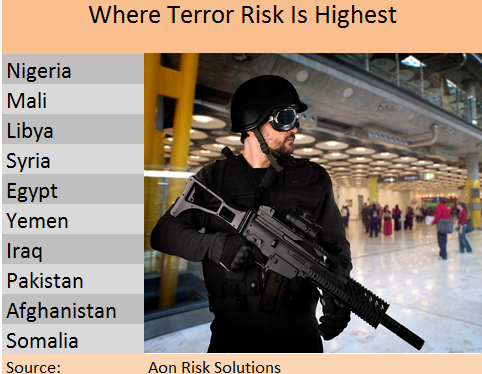The continued threat of a terrorist attack or political violence worldwide persists and is not going away anytime soon.
Despite 19 countries showing improved terrorism and political violence ratings, according to Aon’s 2013 Terrorism and Political Violence Map, 44 percent of countries measured in the analysis have an identifiable risk of terrorist attacks.
“Terrorism is having an increasing impact on today’s global organizations and terrorist attacks are now regarded as a foreseeable risk,” said Neil Henderson, head of Aon Risk Solutions’ Crisis Management Terrorism team. “An attack not only on, but near an organization’s premises can result in human casualties, property damage, business interruption, legal liability issues and long term damage to brand and reputation.”
Aon Risk Solutions’ 10th annual Terrorism and Political Violence Map helps companies assess risk levels of political violence and terrorism. Produced in collaboration with global risk management consultancy The Risk Advisory Group plc, the 2013 Map is complemented by an online and interactive version providing clients a global and country level view on terrorism and political violence ratings.
The three perils measured indicate the different forms of political violence most likely to be encountered by businesses:
- Terrorism and sabotage
- Strikes, riots, civil commotion and malicious damage to property
- Insurrection, revolution, rebellion, mutiny, coup d’etat, war and civil war.
Color-coded ratings of the 200 countries and territories measured act as a gauge for the overall intensity of the risk of terrorism and political violence to business in each country.
The data shows:
- 11 upgrades (increased risk ratings), including Argentina, Egypt and Jordan.
- 19 downgrades (decreased risk ratings), including Germany, Italy and the U.K.
- 44 percent of countries measured have an identifiable threat of terrorism, with the worst affected being Afghanistan, India, Iraq, Nigeria, Pakistan, Russia, Somalia, Syria, Thailand and the Yemen.
- Europe has the most positive regional outlook, with 47 percent of the countries with lowered risk ratings this year. This reflects receding civil unrest associated with the financial and economic crises. Limited incidents of terrorism outside of Greece and Northern Ireland also accounted for lowered risk scores.
- Lingering after-effects of the Arab Spring on regional security and stability remain evident. The Middle East is the most unstable region, with 64 percent of its countries attaining high or severe risk ratings, reflecting terrorism, unrest and conflict risks.
- The Middle East and North Africa region witnessed the highest proportion of countries with a terrorism and sabotage peril, at 85 percent.
“The global economic crisis, shifting geopolitical balances and two years of unusually high levels of civil upheaval present challenges and opportunities for businesses looking to expand,” said Henry Wilkinson, head of the Intelligence and Analysis practice at Risk Advisory.
“North and West Africa and the Middle East stand out as regions of increasing risk. Civil wars in Libya and Syria in particular have contributed to violent risks in nearby countries. Egypt returns to the highest risk rating this year due to persistent civil tumult, political instability and terrorism,” Wilkinson said. “While Northern Europe has seen some improvements, evident in the U.K.’s improved rating, fiscal and economic pressures mean businesses in Southern European countries still face a higher level of risk associated with civil disruption.”
Methodology and resources
The map measures political violence and terrorism in 200 countries and territories to help companies assess the risk levels of exchange transfer, political violence and terrorism. Produced by Aon in collaboration with global risk management consultancy The Risk Advisory Group plc, the Aon Terrorism and Political Violence Map reflects data recorded by Terrorism Tracker*, Aon WorldAware* and an expert assessment of the security situation. Each country is assigned a threat level, starting at negligible, and rising through low, medium, high and severe.
Terrorism threat is defined as an assessment of the intent and capability for terrorist groups to stage attacks and the likelihood they will succeed.
The map can be accessed at http://www.aon.com/terrorismmap
Source: Aon Risk Solutions




















 Insurance Costs, Climate Concerns Factor Heavily in U.S. Home Buying Decisions
Insurance Costs, Climate Concerns Factor Heavily in U.S. Home Buying Decisions  First Atlantic Hurricane Forecast for 2026 Suggests Season Close to 30-Year Norm
First Atlantic Hurricane Forecast for 2026 Suggests Season Close to 30-Year Norm  Five AI Trends Reshaping Insurance in 2026
Five AI Trends Reshaping Insurance in 2026  Northern California Flooding This Weekend Caused by Heavy Rain, High Tides
Northern California Flooding This Weekend Caused by Heavy Rain, High Tides 






